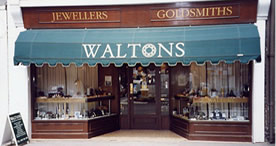UNDERSTANDING PEARLS
A pearl is formed by an irritant getting inside an oyster. This can either be a grain of sand which would result in a natural pearl or a mother of pearl bead can be inserted to create a cultured pearl. The oyster’s defensive system against the irritant is to coat it with layers of ‘nacre’ forming a pearl. A pearl’s value is dictated by its origin, size, colour, roundness & lustre. It is worth remembering that the only way to tell the difference between a natural & a cultured pearl it to have it x-rayed.
Akoya Cultured Pearls: The typical spherical cultured peals as produced by the Japanese Akoya oyster, the pinctada martensii. The term is often used to refer to any spherical cultured peal.
Bina Cultured Pearls: A non-nucleated freshwater cultured pearl. Originally all from Lake Biwa in Japan but the term Biwa is now often used indiscriminately for all fresh water cultured pearls – in fact production in Lake Biwa has almost ceased and many examples, even those sold via Japan, come from China.
Black Cultured Pearls: Naturally coloured (grey to black) type of South Sea cultured pearl. The best are from Tahiti. Rare, expensive and not to be confused with the far commoner artificially coloured cultured pearls.
Freshwater Pearls: Natural pearls produced by freshwater molluscs.
Freshwater Cultured Pearls: Small tissue implants, not beads are used. The result is non-nucleated pearls or ‘tissue graft fresh water cultured pearls’. They are traditionally produced in a large mollusc at up to 30 or more at a time and are typically very cheap and small. The can be in various colours and shaped and sometimes called Biwa cultured pearls (see above), the ‘Rice-Krispie’ type is well known. They are frequently bleached and dyed. However, nowadays, larger spherical non-nucleated cultured pearls are being produced, mainly in China.
Keshi Pearls: Pearls produced as a by-product of the culturing operation – a small non-nucleated, often irregular pearl is found when the oysters are opened at harvest time. The original Japanese Keshi were small (in fact the word means ‘small’ in Japanese) however, larger South Sea Keshis have been marketed in recent years. It is almost impossible to distinguish between Keshi and natural pearls.
Mabé Composite Cultured Pearls: Hollow blister pearls which are filled and then backed by a piece of mother of pearls, typically hemispherical.
Oriental Pearl: A natural pearl and this term can only be used to describe a natural pearl.
Seed Pearl: Very small natural pearls.
South Sea Cultured Pearls: Cultured pearls produced in a very large oyster Pinctada Maxima. Large (generally over 10mm diameter) with thick nacre coatings. Fine examples are rare and expensive. Coloured South Sea cultured pearls should be tested (or given a laboratory certificate) to authenticate colour. The largest producer of South Sea cultured pearls is Australia.


